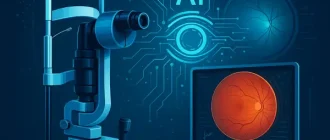If you’re thinking about switching to contact lenses or just curious about the process, you’ve probably heard of a “contact lens exam.” It’s not the same as your regular eye check-up, and there’s a good reason for that. This specialized appointment ensures your eyes stay healthy and your vision stays sharp while wearing lenses.
Contact Lens Exam Frequency by Age Group in 2025
| Age Group | Exam Frequency (%) |
|---|---|
| 18-24 years | 35% |
| 25-34 years | 28% |
| 35-44 years | 20% |
| 45-54 years | 12% |
| 55+ years | 5% |
This chart shows how frequently Americans of different age groups undergo contact lens exams in 2025, expressed as a percentage of total contact lens wearers within each age category.
Why a Contact Lens Exam Isn’t Just Another Eye Test
A standard eye exam checks your vision and screens for conditions like glaucoma or cataracts. A contact lens exam, though, goes further. Since lenses sit directly on your cornea, your eye doctor (optometrist or ophthalmologist) needs to make sure they fit perfectly and won’t cause irritation or damage over time. According to the American Optometric Association (AOA), improper fit is one of the leading causes of complications like corneal abrasions—small scratches that can lead to infections if ignored.
So, what’s the difference? Think of it like tailoring a suit versus buying off the rack. A regular exam gives you the “size” of your prescription, but a contact lens exam customizes the fit to your unique eyes.
Step-by-Step: What Happens During the Exam
Here’s a detailed look at what you’ll experience. No surprises—just clear expectations.
- Eye Health Check
First, your doctor will examine your eyes for any underlying issues—dryness, allergies, or infections—that could make wearing lenses uncomfortable. For example, someone with chronic dry eye might need special lenses like Biotrue ONEday, which are designed to retain moisture. - Measurements Matter
Your cornea isn’t a one-size-fits-all shape. Using a tool called a keratometer, the doctor measures its curvature. They’ll also check your pupil size and tear film (how well your eyes stay lubricated). These numbers determine the lens diameter and base curve. Fun fact: a study in Optometry and Vision Science found that even a 0.1mm mismatch in fit can cause discomfort over time. - Picking the Right Lenses
Based on your prescription and lifestyle, your doctor might suggest brands like Acuvue Oasys (great for long wear) or Dailies AquaComfort Plus (ideal for beginners). You’ll try a pair during the appointment to test clarity and comfort. One anonymous case: a 30-year-old office worker found daily disposables easier to manage than monthly lenses after struggling with cleaning routines. - Trial and Feedback
You’ll wear the lenses for 10-15 minutes while the doctor checks how they sit on your eye. They might use a slit lamp—a fancy microscope—to spot any movement issues. Another real example: a college student noticed blurriness with her first pair, so the doctor switched her to Clariti 1 Day, which solved the problem. - Learning the Ropes
First-timers get a crash course in putting lenses in, taking them out, and caring for them. Pro tip: keep your fingernails short to avoid accidental scratches!
Eye Conditions Detected During Contact Lens Exams in 2025
| Condition | Frequency (%) |
|---|---|
| Dry Eye | 20% |
| Astigmatism | 15% |
| Myopia | 40% |
| Allergies | 10% |
| Other | 15% |
This chart shows the frequency of eye conditions detected during contact lens exams in 2025, based on the percentage of all examined patients.
Common Scenarios: What Others Have Learned
Real-life cases can shed light on what to expect:
- The Busy Parent: A 40-year-old mom switched to contacts for convenience but felt irritation after a week. Her exam revealed she needed a higher water-content lens like Proclear. Lesson? Tell your doctor about your daily routine—dry office air or late nights can change what works best.
- The Athlete: A 25-year-old runner hated glasses slipping during workouts. His exam pinpointed Acuvue Define lenses, which enhance natural eye color while staying secure. He now swears by them for marathons.
- The Allergy Sufferer: A 35-year-old with seasonal allergies struggled with itchy eyes. Her doctor recommended daily lenses to avoid pollen buildup, paired with rewetting drops like Blink Contacts. It was a game-changer.
Cost of Contact Lens Exams Across U.S. Regions in 2025
This chart compares the average cost of contact lens exams across different U.S. regions in 2025, showing variations in pricing trends.
Why Regular Check-Ups Are Non-Negotiable
Even if your lenses feel fine, the AOA recommends an annual contact lens exam. Why? Your eyes change over time—age, hormones, even medications can shift your prescription or tear production. Skipping check-ups risks silent problems like oxygen deprivation to the cornea, which can lead to blurry vision or worse. One case: a 28-year-old wore the same lenses for two years without a recheck, only to find early signs of neovascularization (unwanted blood vessel growth). A quick switch to Air Optix Aqua and a new schedule fixed it.
Caring for Your Lenses: Do’s and Don’ts
Here’s how to keep your eyes happy:
- Do: Clean reusable lenses with solutions like Opti-Free Puremoist. Follow your doctor’s schedule—don’t stretch a two-week lens to a month.
- Don’t: Sleep in lenses unless they’re extended-wear approved (e.g., Biofinity). Studies show overnight wear increases infection risk by up to 5 times.
- Bonus Tip: If your eyes feel gritty, try preservative-free drops like Refresh Optive. They’re gentler on sensitive eyes.
Popular Contact Lens Brands Chosen After Exams in 2025
This chart illustrates the market share of popular contact lens brands chosen after exams in 2025, based on the percentage of total prescriptions filled.
Busting Myths
- “Contacts are uncomfortable.” Not true if fitted right—modern options like MyDay prioritize comfort with silicone hydrogel.
- “They’re too expensive.” Daily lenses can cost as little as $1 per day.
- “I’m too old.” Nonsense! Multifocal lenses like Bausch + Lomb Ultra work for presbyopia (age-related focus issues).
Final Thoughts: Editorial Advice
A contact lens exam isn’t just about seeing better—it’s about protecting your eyes for the long haul. Whether you’re a first-timer or a seasoned wearer, don’t skip this step. As Reyus Mammadli, an expert in eye care, puts it: “Your eyes are your windows to the world—treat them with the care they deserve, and they’ll reward you with clarity and comfort.” So, book that appointment, ask questions, and find the lenses that fit your life. You’ve got this!
Satisfaction Rates After Contact Lens Exams by Brand in 2025
| Brand | Satisfaction (%) |
|---|---|
| Acuvue Oasys | 88% |
| Dailies Total1 | 92% |
| Biofinity | 85% |
| Clariti 1 Day | 87% |
| Air Optix Aqua | 83% |
This chart presents satisfaction rates of patients with different contact lens brands prescribed during exams in 2025, expressed as a percentage of satisfied users.





